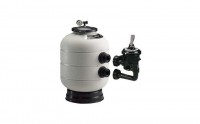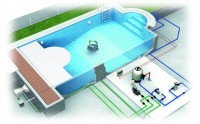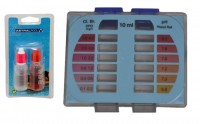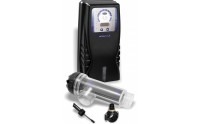Start at the beginning of the season.
At the beginning of the summer season, some preparation of the pool should be done.
The aim is to make sure that all the accessories installed are in good condition and ready for operation so that we can enjoy the pool all summer long.
It is best to start the whole process in the spring so that there is a reasonable amount of time to deal with any minor problems that require specialist support.
It is important to follow the whole process correctly, in order to avoid problems during the season.
for the summer.
1. The swimming pool
• If there is a winter cover, it should be removed for cleaning and left in the sun to dry. The cover can be used again until the beginning of the period to protect the water from dirt and as a safety measure. During the summer season, it is best to use a summer cover.
• The pool walls must first be cleaned. This process can be done either with a vacuum cleaner or with a washing machine, depending on the surface of the pool.
• It is important to inspect the water inlets and various other plastic components that are fitted (skimmer, vacuum cleaner, etc.) for possible damage. The overflow channel and its grate must also be cleaned.
• We check the luminaires if they work properly and for any water entry into the lamps.
• Carefully clean the bottom well of dirt that may have clogged the pipe.
• In case we need to clean the surface of the pool, we use the right chemicals to avoid possible corrosion. There are different cleaners, depending on the final coating of the pool.
• If the pool needs to be emptied to be cleaned more thoroughly, it is best not to do it in very sunny conditions.
• We finish by cleaning the stainless steel parts of the pool (bars, stairs, etc.), where we again use products for the specific application.
2. The engine room
Here is the heart of the pool, including equipment for recycling and water treatment.
First we have to clean the space so that we can work more easily.
The pump.
Put it back in place, in case it has been removed and check the pre-filter if it is in good condition. It should not be broken or corroded if it is metal. Then check the direction of rotation of the motor, if it is three-phase.
• Make sure the pre-filter cap and flange seal properly. At the same time we check if the non-return valve works. Finally, inspect the connections inside the electrical panel and tighten the contacts.
• Look carefully for possible leaks. A small water leak can cause major problems later.
The filter.
The checks that need to be done are related to the type of filter we have.
• In the case of the sand filter, open the lid and check internally. If the sand has become solid, it should be cleaned with the appropriate chemicals. We must empty the water from the filter with the drain plug and refill the filter with water and the appropriate chemical. It will stay like this for 4 hours with the lid open and then we will close the lid and clean the filter sand.
• In the case of a cartridge filter, check the condition of the cartridges and clean them with high pressure water.
Finally, check the connections on the filter and test the windshield to make sure it is working properly.
Overflow tank.
In pools with an overflow tank, it is necessary to check the tank and clean it, if necessary. We also clean the point of water suction from the tank to the pump.
3. Cleaning the pipes
In case we can create recirculation of water without passing it through the filter, it is recommended to clean the pipes from salts and algae deposits.
To do this, we fill the pool as little as possible so that we can recycle the water. Add a strong disinfectant and descaler to the water and put the system in recirculation mode, without the water passing through the filter. Work like this for 30 minutes and then drain the water.
4. Water preparation.
In all pools, the water needs initial adjustment at the beginning of the season. First we have to add or fill the pool with water, to the point that the recirculation is done properly.
When filling the pool (which can take days) add shock chlorine (dichloro) to keep the water in good condition.
When the pool is full, it is necessary to proceed with a dose of shock disinfectant to eliminate germs and contaminants until the excess chlorine reaches levels of 5ppm. We can at this stage add algaecide to prevent the growth of algae.
In addition to disinfecting the water, it is necessary to measure and correct the pH of the water, using the appropriate pH regulators.
It is also important to add the right amount of flocculant, which will help our water to clear and become clearer.
5. Apparatus for water treatment.
• If a salt electrolysis system is in place, the electrolysis electrode should be removed and the plates cleaned. The method of cleaning varies depending on the manufacturer. The salinity of the water should also be measured, either with the electrolysis device or with the appropriate instrument.
• Cl and pH automations need special attention. Their proper operation ensures clean and healthy water during the use of the pool, but for this to happen they must have been properly maintained. The electrodes need to be checked for measurement accuracy and it is recommended to replace them every 1-2 years. In any case, they need calibration according to the procedure provided by the manufacturer.





